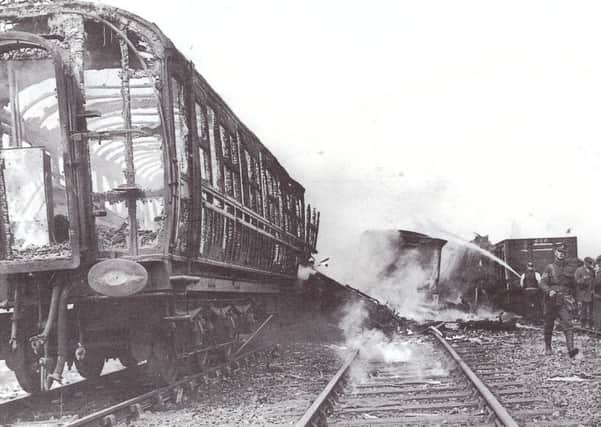Quintinshill rail disaster remembered


On that morning one hundred years ago at 6:49am, fate conspired to create what remains the biggest loss of life on Britain’s rail network.
In total, 226 people died and 246 were injured when five trains crashed at Quintinshill, an intermediate signal box on the Caledonian Railway Main Line (now the West Coast Main Line) near Gretna Green.
Advertisement
Hide AdIn the course of a few minutes of “shock and flame”, half of the battalion of the 7th, or Leith, Royal Scots, who were travelling to Liverpool bound for Gallipoli, were wiped out. Of the 500 soldiers on the old wooden gas-lit troop train, only 60 made it to roll call the next morning.
The official cause of the accident was poor working practices on the part of the two signalmen – the troop train had smashed into a stationary local train which had been mistakenly parked on the south line.
It resulted in them both being jailed for culpable homicide. Much about the accident, however, is still unknown, including the precise number of fatalities as the roll of the regiment was destroyed in the fire.
That fateful day would have started so differently for the young troops, who were no doubt full of adrenaline-fuelled excitement as they sat on board the train ready to join the fight for King and country.
The territorial battalion had been on coastal defence duties on the Forth since the outbreak of war but moved to Larbert before a planned deployment to France. At the last moment, orders were received changing their deployment to Gallipoli.
They had been due to leave Larbert on 21 May but their departure was delayed for 24 hours after their troopship ran aground in the Mersey. The train finally set off at 3:45am.
Advertisement
Hide AdAt Quintinshill, signalman George Meakin was on night shift, no doubt looking forward to being relieved by colleague James Tinsley. If they had been working according to regulations, Tinsley would have taken over from Meakin at 6am. The two men, though, had an informal arrangement allowing whoever was working the early shift to arrive half an hour later so they could hitch a ride on a local train. It was a fatal arrangement.
A Board of Trade report suggested Tinsley was distracted by chatter about war news so he forgot about the local train on which he had himself arrived.
Advertisement
Hide AdIt had been parked on the up line to let the London to Glasgow express through, as both “passing loops” were already occupied. The special troop train was tragically given the go-ahead to proceed and smashed into the local train.
The train overturned on to the northern line and a minute later the express ploughed into the wreckage. A goods train in the down loop and an empty coal train in the up loop also became embroiled in the carnage.
Gas cylinders exploded, with the result that men were trapped in the burning wreckage. The flames took hold in the obsolete wood-framed carriages (pressed into service by wartime demand) and coal from the bunkers of the steam engines.
So fierce was the fire that the remains of many soldiers could not be properly identified, and men were still unaccounted for more than a week later.
The Scotsman reported the horror. “The wreckage took fire immediately, and was consumed. The circumstances of the disaster render it impossible to state the total loss of life as the number who perished in the flames cannot be ascertained.”
Gradually, lists of casualties were published, with photographs, obituaries and death notices. When the coffins arrived back in Edinburgh before the funeral, relatives were not allowed to open them. As the weeks went by, the amount of space devoted to the accident diminished, but photographs of men killed were still appearing in the middle of June 1915.
Advertisement
Hide AdThe dead were buried in a mass grave in Edinburgh’s Rosebank Cemetery on Pilrig Street after a four-hour cortege through the city, the coffins laid three deep with each on the top row covered in the Union flag.
The soldier survivors, meanwhile, dishevelled and demoralised, were transported south to army barracks. To add to the tragedy, on their march from the railway to the barracks, they were mistaken for prisoners of war and stoned by onlookers.
Advertisement
Hide AdPerhaps most tragically is that among the coffins were four little bodies. One coffin was simply labelled “little girl, unrecognisable”, and another “three trunks, probably children”.
Suspected stowaways, they were never identified and were buried in Glasgow’s Western Necropolis on 26 May, 1915.